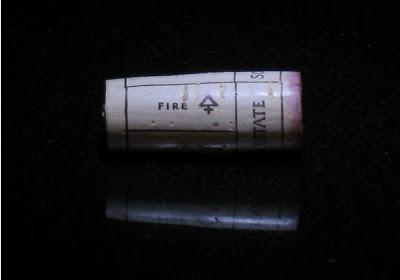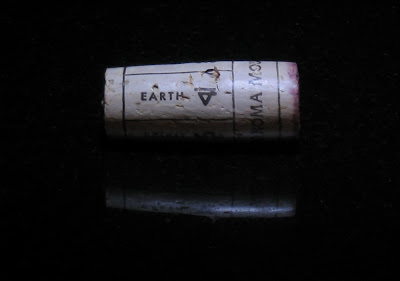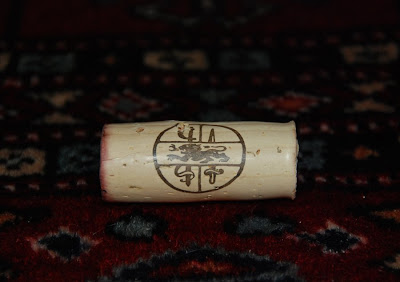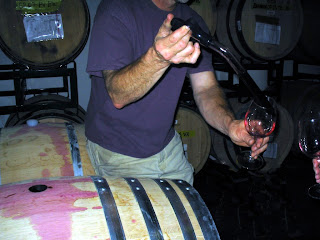I was reading over on Dr. Debs this morning about wine corks. It has inspired me to dust off some of my favorite cork photos. As with most SLG photos, you can click to enlarge them.
The first five photos are from Benzinger Oonapias Sonoma Mountain Red.




I do not remember which bottle of Benziger Family Winery wine this came from. Benziger corks are great because their graphics are easily viewed without rotating the cork.
The next two corks were more whimsical. Plus they are photogenic. Here we have two French turtles enjoying a bottle of Tortoise Creek Les Amoureux. 
Finally, we have Toad Hollow. This wine was from Taster B’s posting Weekend Wino-ers: Merlot-quacious! This was our farewell to the bad Sideways juju. We feel it is our inalienable right to enjoy Merlot--and we do.
And what would a posting about corks be without a tribute to "Old Reliable" who has never split a cork on me. 
Sadly, there may come a when we no longer need our "Old Reliables" any more.
Saturday, April 12, 2008
Corked
Thursday, April 10, 2008
Dill-Licious Flavors of Spring!
 I was attracted by a display of all things green in the produce section the other day. As my eye wandered over fleshy green mounds of swiss chard and collard greens, my nose caught the pungent and bright aroma of something wonderful and herbaceous. It was dill: Piles of lacey dew-laden bunches of tangy dill beckoning me from three feet. "What would I do with d-" oh screw it. I'm not leaving without some of this stuff.
I was attracted by a display of all things green in the produce section the other day. As my eye wandered over fleshy green mounds of swiss chard and collard greens, my nose caught the pungent and bright aroma of something wonderful and herbaceous. It was dill: Piles of lacey dew-laden bunches of tangy dill beckoning me from three feet. "What would I do with d-" oh screw it. I'm not leaving without some of this stuff.
What to do with Dill
Cucumbers are famously well-paired with dill. So, of course, I made some tzatziki (recipe follows) but, really when you have fresh dill in the house, dill goes with just about anything.
We had some chicken thighs with a side of purple/red potatoes dressed with a little butter, sea salt, a squeeze of lemon juice, and a healthy dose of dill. Fresh dill is very mild yet tangy which makes it great with anything that you would season with lemon such as fish, like salmon. When it comes to wine pairings, I don't think you have to be timid. We aren't talking about pickles here. I think most whites would do. Why not try an Alsace Riesling such as Domaine Zind-Humbrecht? The brightness of the wine and the dill play off eachother and heighten the citrus notes of orange in the wine and the green notes in the dill. So go ahead: Dill out!
When it comes to wine pairings, I don't think you have to be timid. We aren't talking about pickles here. I think most whites would do. Why not try an Alsace Riesling such as Domaine Zind-Humbrecht? The brightness of the wine and the dill play off eachother and heighten the citrus notes of orange in the wine and the green notes in the dill. So go ahead: Dill out!
2005 Domaine Zind-Humbrecht
Alsace Riesling
Aromas: apple, butter, vanilla, lychee
Flavors: citrus, sweet apple, mineral
Tzatziki
1/2 C of good Greek Yogurt (if you have to use sub-par greek yogurt, you're going to want to drain it in cheese cloth overnight to get rid of the excess moisture)
about 1/2 a cucumber grated (drained on paper towel for 1-2 hours)
1-2 cloves of roasted garlic, minced
dash of ground thyme
pinch of sea salt
1.5 T fresh finely chopped dill
1/2 t olive oil
serves: 2-3
Tuesday, April 8, 2008
Amarone della Valpolicella Classico, the Forgotten Wine

Taster B made cheese lasagna tonight. We have a few Italian reds in the loft cellar. It is always a challenge to pick just one. I found a wine that neither one of us remembered buying nor how much we paid for it. Mystery wine!
Amarone della Valpolicella Classico DOC is a wine from the Northeast region of Italy around the city of Verona Veneto. I’m having a difficult time figuring out what is in this wine so I’m not going to bluff my way through it. The principle grape seems to be Corvina with a laundry list of other possible allowed grapes. I will give you a word of warning about Valpolicella wines, the area is riddled with plonk. This is true of so many areas of Italy, so much so that it sounds like I’m getting Alzheimer’s. Classico may be a safe way to go. In recent years, Valpolicella has been cranking out some great wines so if you are a careful shopper, you can get yourself a really cool wine. So if you have a chance to grab an Amarone della Valpolicella Classico, give it a whirl.
What you will be in for is a rich red wine, strong cherry, tobacco, chocolate and earthiness, a full bodied wine that shows some great complexity. Don’t be surprised if you find an old bottle at your wine shop. These wines tend to be aged quite a bit before released.
So what was this wine like? I’m happy to present my tasting notes.
Amarone della Valpolicella Classico, D.O.C.
Villa Fulvia
Vintage: 2002
Alcohol: 15.0%
Price: We Forgot!
Color: Ruby red
Intensity: Dark
Aromas: Blackberry, cherry, plum jam raisin, olive, earth
Flavors: Strawberry, blackberry, cherry, plum, current, olive, tar, stuck flint, smoky, Slovenian oak, coffee, chocolate, tobacco
Body: Full
Acidity: Moderate
Sweetness: Off-dry
Tannins: Silky
Finish: Long
Summary: Nice package of fruit and chocolate. In the late finish tar, tobacco and mocha. This wine has a bit of glycerin and has legs like Betty Grable. Taster B commented that it is a little unbalanced: heavy on the alcohol and light on the acid. I tend to agree but don’t let this scare you off. The wine is more blackberry than cherry. Yeah, I’d buy this one again.
This can be enjoyed on its own, paired with garlic bread, herbed cheeses, Tuscan steak, grilled meats and grilled veggies.
Posted by
Taster A
at
8:02 PM
![]()
Tags Italian Labels, Italian Wine
Sunday, April 6, 2008
Are there too many wines out there?
Up on the OWC, there is a conversation about the vast numbers of wine brands out there and the lack of brand loyalty. Reading through these comments was interesting. I’m not sure if there is a real problem statement here to solve. There seemed to be a common thread that there are a bazillion labels out there and there seems to be a shrinking number of staff out there to guide the consumer properly. Wine is an agricultural product. But unlike most agricultural products, there is variation. For instance, you go out to buy a tomato. Do you like Big Boy, Beef stake, Roma or those little pink handballs that are grown in a hot house? You can get conventional or organic. Those are the choices.
Wine is an agricultural product. But unlike most agricultural products, there is variation. For instance, you go out to buy a tomato. Do you like Big Boy, Beef stake, Roma or those little pink handballs that are grown in a hot house? You can get conventional or organic. Those are the choices.
With wine, there is a wide variation. Perhaps when you step away from the Yellow Tails, Gallo brands and Constellation producers, you get into a level of art. And that is why we are here. To my knowledge, there isn’t a tomato blogging community, people don’t aspire to buy a tomato truck farm in Florida to live the good life. There are no tomato snobs out there.
No, wine is a unique agricultural product. There is an art to making wine and there is a tech to getting it onto the shelves. Before that, the marketing department has to stress over which animal to put onto the label to capture the public’s attention. (I wonder who thought of a using a penguin?)
With wine, I’m rather thankful that we have this problem of which wine to buy. Come on now, isn’t it fun to figure this wine thing out?
Posted by
Taster A
at
10:23 AM
![]()
Saturday, April 5, 2008
An introduction to wine barrels
 Most people take for granted that wine is fermented in oak barrels. Many woods can be used to make a container. Oak has some rather unique properties that make it the wood of choice for wine. If you are going to store your livelihood in a container, the container must hold the wine, preserve the wine and not impart bad tastes to the wine. From a manufacturing standpoint, the wood must be able to be fashioned into a container, not leak, be readily available, economical and have repeatable results.
Most people take for granted that wine is fermented in oak barrels. Many woods can be used to make a container. Oak has some rather unique properties that make it the wood of choice for wine. If you are going to store your livelihood in a container, the container must hold the wine, preserve the wine and not impart bad tastes to the wine. From a manufacturing standpoint, the wood must be able to be fashioned into a container, not leak, be readily available, economical and have repeatable results.
Looking at other woods, you can make containers out of beech, pine, spruce, poplar, redwood or even willow. Most of these woods will impart a taste that is bitter, too aromatic or even a smell like turpentine. Maple would be a good choice, but for anyone out there that has worked with maple knows that it is a dang hard wood that doesn’t form well.
Oak has been used for cooperage for a reason. It is easy to form into staves, it splits well and has a tight enough grain to hold the product. Oak has some flavorful oils that impart a pleasant vanilla characteristic that is complimentary to wine. It also helps with tannin structure. This is why we have a long tradition of storing wine in oak barrels. They are rugged (much harder to break than fired clay jars) and they give a level of insurance that the product will arrive in one piece (literally).
Wine makers have a choice of cooperage. There are many species of oak used to make wine barrels. In America, (and I’m not going to bore you further with Latin names) we have American White Oak. This oak will impart a stronger, more pungent wood characteristic to the wine. In Europe we find Brown Oaks. These are more tight-grained, have finer tannins and a lighter vanillin make up.
Barriques like those shown below are used for high end wine. They are expensive. An American barrique costs about $450 and a French oak barrel can go for around $850. 
Another choice the wine maker has it is the degree of toast the barrel has. Wine barrels are intentionally charred, scorching the surface of the oak changes the aromatic oils and cellulose on the surface to complex compounds. This can impart pleasing characteristics to the wine if done correctly.
The age of the barrel will have an effect on the wine. New barrels will have the largest effect, imparting strong flavors. Used barrels will allow the wine to age with gentler affects. Some wineries will age part of the vintage in new oak, some in old oak and make a blend to get the most balanced composition. Likewise, a wine maker may decide to make part of the vintage in French oak and part in American oak. There are all sorts of stylistic decisions to make.
A final decision is the size of the barrel. The smaller the barrel, the larger the surface area to wine ratio. This means more surface contact for the wine and a greater influence the oak will have.
Oak has become so popular that there are products for wine makers to impart oak characteristics to wine without using expensive barrels. Yes, there are wood chips, staves and “shelves” that can be used to manipulate the wine. These products are often added to stainless steel fermentation tanks to help add structure.
Volume producers have been using oak chips since the early 1960s. The oak chip has been a covert fact. These chips are available in different toast levels and can even be used in old barrels to produce that new barrel taste.
This is all important to wine appreciation because you will have oak preferences. My suggestion is that you set up a horizontal flight of wines to tastes the differences. You can talk with your wine shop proprietor to help you select some wines with different oak influences.
The Tonnellerie Quintessence site has an excellent video that shows the barrel making process from forest through shipping. It includes interviews with wine makers.
Another good learning resource is this page from T. W. Boswell.com that gives a list of barrels and toast levels and the influence intended on the wine.
With all this knowledge, you will know more about the wines you have a preference for. I hope it has been of value to you.
Posted by
Taster A
at
9:07 AM
![]()
Tags wine education, wine making
Wednesday, April 2, 2008
Ahhh Toscana
Taster B emailed me at work with instructions that when I got home I was to take the pizza dough out of the refrigerator. We’re having pizza tonight. She made a pizza sauce and topped the pizza with fresh mozzarella, tomato slices, red pepper and onion. It was up to me to pick a bottle and do a quick photo shoot.
There were several wines that I could have gone with, but I settled on a Toscana that we picked up back in January at The Vineyard in January. Wine can be a fickle friend. In January, we got notes of tobacco, rose and coffee. That was in the middle of tasting 23 wines. It goes to show how perceptions of wine can change with different foods and following other wines.
Nevertheless, this is a great wine for the price and worth looking for. We’ve talked a little about Toscana IGT wines before and if you are new to Italy, you can learn about the style and how to read the labels. Toscana IGT
Toscana IGT
Santa Cristiana Antinori
Vintage: 2006
Blend: Sangiovese 90%, Merlot 10%
Alcohol: 13.0
Price: $11.99
Color: Ruby Red
Intensity: Medium
Aromas: Strawberry, cherry, smoked meat, tobacco
Flavors: Strawberry, raspberry, cherry, curry, mineral, anise, sage, licorice, vanilla
Body: Full
Sweetness: Off dry
Tannins: Silk
Finish: Moderately long
Summary: Nice berry wine, smooth tannins, with mineral dried berry/cherry finish. In the long finish, spicy licorice and anise notes develop. We really enjoyed this with our moderately-topped juicy veggie pizza. We were very glad we picked up this wine and would buy it again.
Most folks don't regard pizza as a great meal. Pizza is very commonplace and is usually only a phone call away. The Hut has slipped in quality over the past 30 years and most pizza tastes about the same as the box. One of the tricks is getting the crust right and today, pizza dough is available at many delis.
Well made pizza is always a hit. In my younger day, perhaps 10 pounds ago, I would have put a pound of mozzarella and another pound of cheddar on a pizza. Today, I’m just as happy with one third of a pound.
Having good wine to go with a good pizza is a must. Sangiovese is a great compliment. This wine also goes with lamb, duck, cold cuts, Cioppino and hard cheese.
Posted by
Taster A
at
6:11 PM
![]()
Tags Italian Wine, sangiovese, Super Tuscan, Toscana, wine under $15
WBW #44 Loire Lovefest...or not.
![]() Wow! This WBW comes on the heels of a Wine Blogging firestorm concerning the sudden appearance on the scene of meta-wine-blog spoof WINE-ING 2.0. Efforts to ascertain the identity of the mastermind behind the site carried on throughout the weekend and into Tuesday amidst swirling accusations. Earlier speculation seemed to point to our own WBW Founder, Lenn Thompson but, the exposé turned out to be another red herring. At the time of this writing, it is not clear if any further investigation is being pursued as wine bloggers began to realize late Tuesday that they might prefer not to learn the author's true identity.
Wow! This WBW comes on the heels of a Wine Blogging firestorm concerning the sudden appearance on the scene of meta-wine-blog spoof WINE-ING 2.0. Efforts to ascertain the identity of the mastermind behind the site carried on throughout the weekend and into Tuesday amidst swirling accusations. Earlier speculation seemed to point to our own WBW Founder, Lenn Thompson but, the exposé turned out to be another red herring. At the time of this writing, it is not clear if any further investigation is being pursued as wine bloggers began to realize late Tuesday that they might prefer not to learn the author's true identity.
In light of recent developments, I’m sure I’m not the only member of the wine blogging community who found it difficult to get off social-networking app turned real-time newsfeed, Twitter and get down to the business of writing up a kick-ass WBW post that would show well beneath the glow cast by Wine 2.0 Brand Giant, gary vay•ner•chuk. Powered by Viddler
Another thing that made this WBW difficult to write is the fact that I couldn’t find many nice things to say about the wine I selected. Gary is such a positive person, and I really wanted to echo that positivity. Gary gives so much and I wanted to return the flow so, to that end, I put together this collage to salute our famous WBW #44 host.
Sorry about Corky Gary. You understand I don’t think it’s too late for him I just thought this might be what you needed to see right now to help avoid such a fate for potential Killer App, cork’d™. (For anyone not familiar with Tenacious D & the POD, the evil-looking green horned thing actually symbolizes the magical quality that transforms mere mortals into Rock Stars)
Now for the wine which was a Jean-Marie Raffault Les Galuches Chinon 2005. This wine actually would be really good in a blend. I could see blending a barrel of this wine with say, sixteen barrels of Cabernet Sauvignon and 3 barrels of Merlot; that would be good. It would also be okay to use this bottle, which retails around $13-$18, in a stew. Other than that, the best thing about this rather unattractively labeled bottle of Chinon is the photo I took featuring my Pysanky eggs. It was very difficult to find a Loire red wine in my area and this was actually the only bottle available in the 4 wine shops we visited. I wish we could have found another one to compare it to. We have had good Cab Franc but it was from Long Island . I wish we’d had time to buy the WBW Sampler Pack from Domaine547 [ "ripping cute!” –gary vaynerchuck, WLTV]. We sampled this wine three different times over the course of three nights. We tried it paired with lamb, with chicken, with hard cheese, with steak. Gary? Was this French Cab Franc theme your April Fools joke? The wine tasted like burnt strawberries: If you took a piece of unripe fruit and completely carbonized the outer layer, that’s what this wine tasted like. Was the wine corked? It didn’t have the musty aroma or vinegary flavors that I would normally detect in a corked bottle. Actually, out of curiousity, I looked up some tasting notes from Wine Advocate: “beef broth” (yep) “iodine” (yep) “faintly saline on the palate” (mm-hmm)... This was not the worst bottle of wine I’ve ever had. It was simply the worst bottle (IMHO) that I’ve ever had to post on my blog.
It was very difficult to find a Loire red wine in my area and this was actually the only bottle available in the 4 wine shops we visited. I wish we could have found another one to compare it to. We have had good Cab Franc but it was from Long Island . I wish we’d had time to buy the WBW Sampler Pack from Domaine547 [ "ripping cute!” –gary vaynerchuck, WLTV]. We sampled this wine three different times over the course of three nights. We tried it paired with lamb, with chicken, with hard cheese, with steak. Gary? Was this French Cab Franc theme your April Fools joke? The wine tasted like burnt strawberries: If you took a piece of unripe fruit and completely carbonized the outer layer, that’s what this wine tasted like. Was the wine corked? It didn’t have the musty aroma or vinegary flavors that I would normally detect in a corked bottle. Actually, out of curiousity, I looked up some tasting notes from Wine Advocate: “beef broth” (yep) “iodine” (yep) “faintly saline on the palate” (mm-hmm)... This was not the worst bottle of wine I’ve ever had. It was simply the worst bottle (IMHO) that I’ve ever had to post on my blog.
Thanks again to our affable host Gary Vaynerchuck for bringing the Thunder to this month’s WBW. It was fun! We don’t have a WLTV badge link to Wine Library TV on Smells Like Grape for the simple reason that everybody else does. However, I'll make an exeption in honor of this momentous occassion.
Posted by
Taster B
at
3:45 AM
![]()
Tags Cabernet Franc, Loire Valley, WBW






1 comments:
Post a Comment